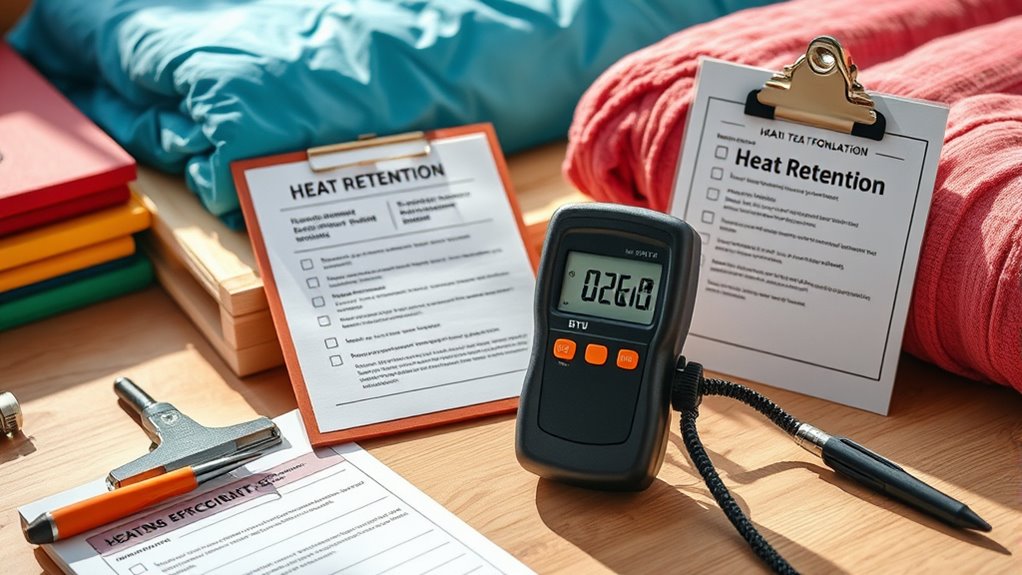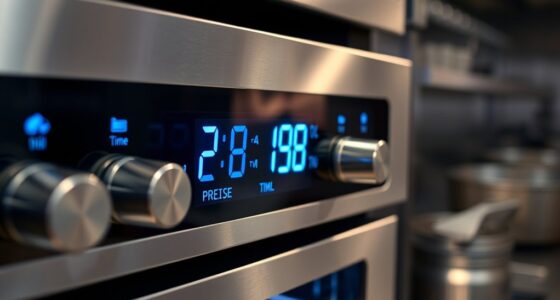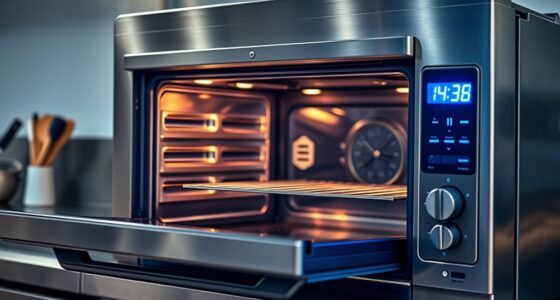Before you start, make certain you measure your room’s dimensions accurately—length, width, height—and consider its shape and external features like windows and doors. Assess insulation quality and seal any gaps to improve heat retention. Evaluate external factors such as weather and sun exposure, and choose a heating system with appropriate BTU capacity, fuel compatibility, and proper placement. Getting these basics right helps optimize energy use and comfort—continue exploring to master all essential heat retention strategies.
Key Takeaways
- Measure your room’s dimensions and shape accurately to determine total volume and heating needs.
- Calculate BTU requirements based on insulation quality, window placement, and external factors like climate.
- Assess insulation effectiveness and improve it to enhance heat retention and reduce energy loss.
- Ensure heating equipment matches your space size and fuel source for optimal efficiency and safety.
- Consider outdoor conditions and external factors that impact heat retention and overall heating performance.
Understanding Your Space Dimensions and Layout
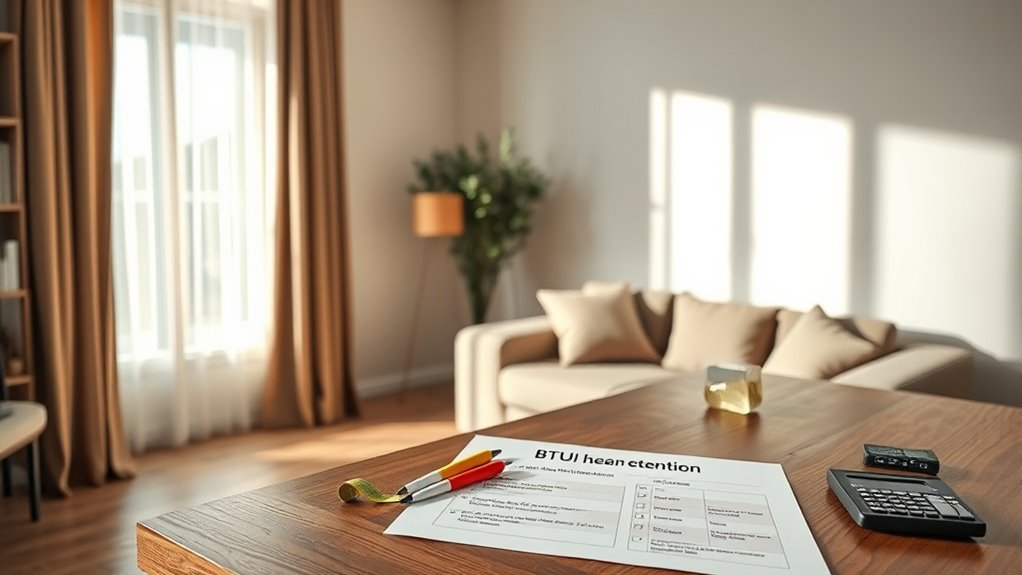
To effectively determine the right BTU requirements for your space, you first need to understand its dimensions and layout. Start by measuring the room’s length, width, and height to get accurate volume. Consider the room shape—whether it’s rectangular, square, or irregular—as this impacts heat distribution. Wall placement also matters; rooms with exterior walls, large windows, or multiple openings can lose heat faster. Knowing the layout helps you identify areas that might need extra insulation or strategic placement of vents and radiators. Keep in mind that oddly shaped spaces or those with unusual wall placements may require different heating considerations. Additionally, understanding the heat retention characteristics of your space can help you select the most efficient heating system. Accurately evaluating these factors ensures your heating system will be properly sized and efficient, keeping your space comfortable year-round.
Calculating the Appropriate BTU Needs for Your Room
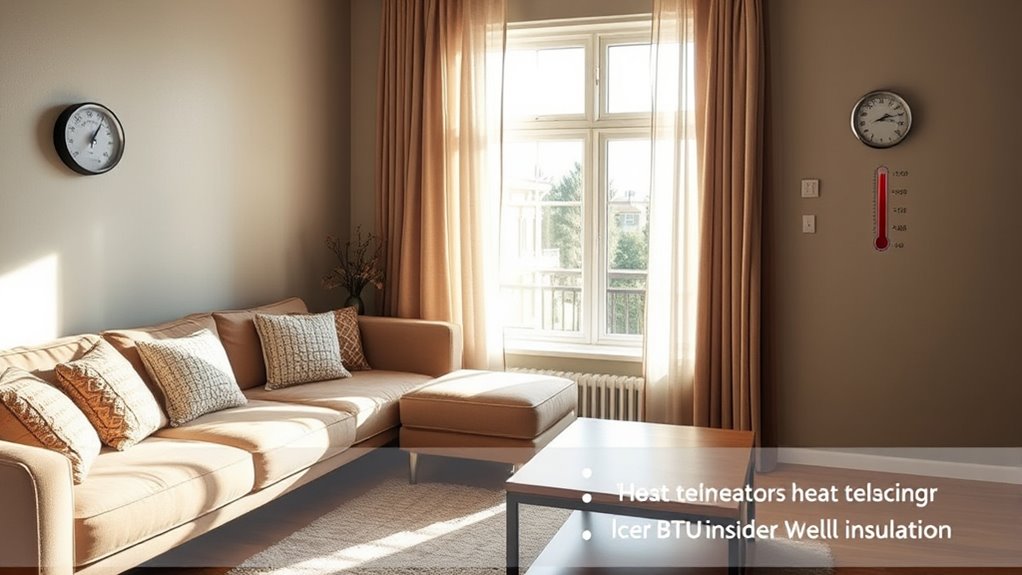
Once you’ve measured your room’s dimensions and considered its layout, the next step is calculating how many BTUs are needed to heat it effectively. Start by estimating the room’s size, then adapt based on factors like ceiling height and window placement. Proper thermostat placement is key—placing it away from drafts or direct sunlight ensures accurate temperature readings. Additionally, consider heating zone zoning; dividing your space into zones allows tailored heating, reducing energy waste. If your room is larger or has unique features, increase the BTU estimate accordingly. Keep in mind that an undersized unit won’t keep the room warm, while an oversized one can cause temperature swings. Accurate calculations help you choose the right heater and maintain consistent comfort throughout your space. Understanding heat retention and insulation quality can further refine your BTU needs for optimal efficiency.
Assessing Insulation Quality and Its Impact on Heat Retention
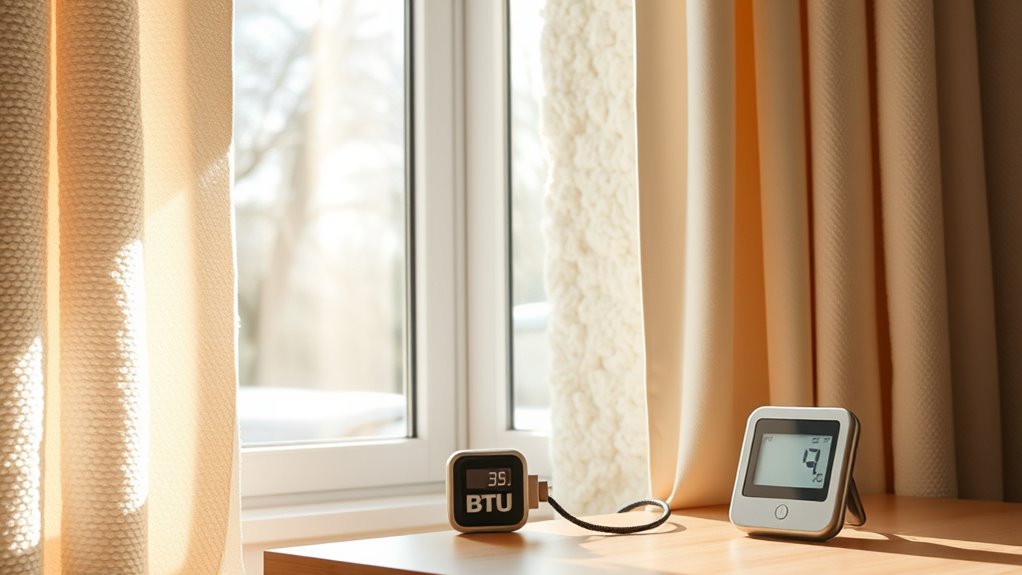
Evaluating the quality of your insulation is essential because it directly influences how well your space retains heat. Start by examining your insulation materials—fiberglass, foam, or mineral wool—and check for gaps, compression, or damage. Good insulation acts as a thermal barrier, reducing heat transfer between your interior and the outside. Proper insulation is crucial for maximizing heat retention and energy efficiency. If your insulation is outdated or improperly installed, heat escapes more easily, forcing your heating system to work harder. You can test insulation effectiveness with a thermal camera or simple touch tests around walls, floors, and ceilings. Improving insulation quality enhances heat retention, lowers energy costs, and creates a more comfortable indoor environment. Remember, well-installed, high-quality insulation is a key component in maintaining consistent warmth.
Identifying Windows, Doors, and Ventilation Factors

Your windows, doors, and ventilation systems play a vital role in heat retention. Poorly insulated windows or unsealed doors can let heat escape, while ventilation impacts airflow and temperature control. By understanding these factors, you can identify areas to improve for better energy efficiency. Additionally, sealing gaps around ventilation systems can prevent unwanted heat loss and improve overall insulation.
Window Insulation Quality
Windows, doors, and ventilation points play a crucial role in your home’s insulation quality, as they are common sources of heat loss. To evaluate your windows, start by inspecting the window frame; gaps or deteriorated seals can let warm air escape. The glass thickness also matters—thicker glass provides better insulation by reducing heat transfer. Double-pane windows with low-emissivity coatings are more effective at retaining heat than single-pane options. Check for drafts around the frame and ensure seals are tight. If your windows are older or poorly sealed, they could considerably decrease your heat retention. Upgrading to energy-efficient windows with insulated frames and thicker, coated glass can make a noticeable difference in retaining warmth and lowering your BTU needs. Additionally, understanding high contrast ratios in projectors can help optimize your home theater’s image quality, creating a more immersive viewing experience.
Door Sealing Effectiveness
How effectively your doors seal can substantially impact your home’s heat retention. A tight door gasket ensures minimal air leaks, keeping warm air inside and cold air out. Inspect your door gasket regularly for signs of wear or damage, replacing it if needed. Sealant integrity around the door frame is equally important; cracks or gaps can let heat escape. Use weatherstripping or door sweeps to improve seal quality. Remember, even small gaps can considerably reduce your home’s efficiency and increase heating costs. Test your door’s seal by closing it on a dollar bill—if it slips out easily, the seal needs attention. Maintaining a good seal helps preserve heat and reduces the workload on your heating system. Additionally, door sealing effectiveness can be optimized through regular maintenance and upgrades, ensuring your home remains energy-efficient.
Ventilation System Impact
Effective ventilation systems play a crucial role in maintaining your home’s thermal efficiency by balancing air quality with heat retention. The air exchange rate determines how often fresh air replaces indoor air, directly impacting heat loss. Windows, doors, and ventilation openings influence this rate, making it essential to identify their placement and sealing effectiveness. An overly high ventilation rate can lead to significant heat escape, reducing your home’s warmth and increasing energy costs. Conversely, inadequate ventilation can cause indoor air quality issues. To optimize heat retention, ensure that windows and doors are properly sealed and consider controlled ventilation options. Understanding how these factors affect air exchange helps you find the right balance between fresh air and heat conservation, maximizing your home’s energy efficiency. Regular assessment and vertical storage solutions can also reduce clutter that might obstruct vents or airflow pathways, further improving efficiency.
Considering External Factors Affecting Heating Efficiency

External factors can profoundly influence the efficiency of your heating system, often making it harder to keep your indoor temperature comfortable. Solar shading helps reduce heat gain from direct sunlight, preventing your space from warming up excessively and easing your heating load. Proper shading can also protect windows from heat loss during colder months. Outdoor heating options, like patios or outdoor fireplaces, can impact your home’s overall heat retention by introducing additional heat sources that might affect indoor temperature regulation. Windy conditions can increase heat loss, so installing windbreaks or insulating exterior walls can help. Additionally, the orientation of your home influences how much sunlight it receives, which affects natural warmth and your reliance on artificial heating. Effective window insulation can also play a significant role in maintaining indoor warmth and reducing energy costs. Considering these external factors allows you to optimize your heating efficiency effectively.
Choosing the Right Heating Equipment Based on Your Needs
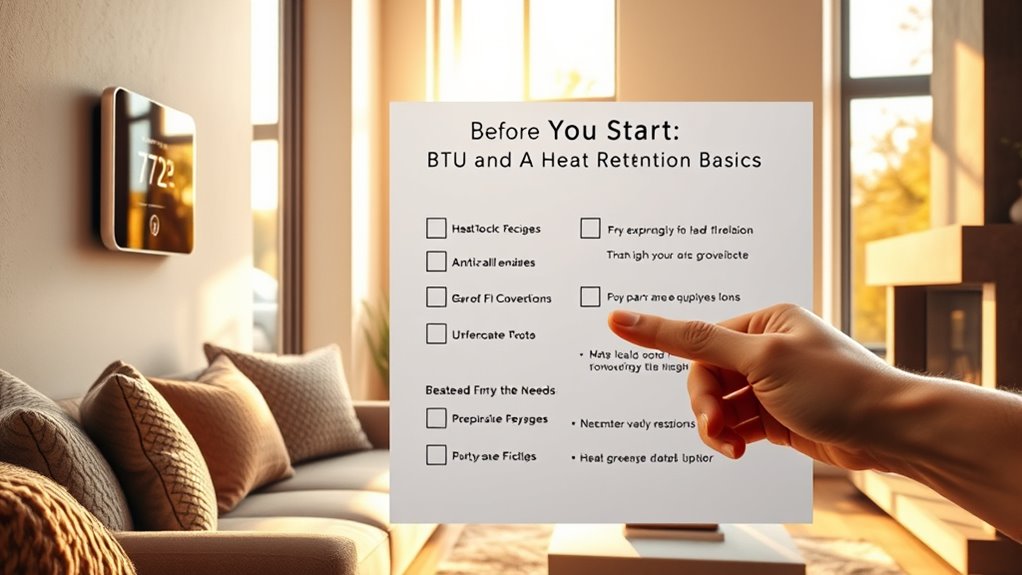
When selecting heating equipment, you need to consider its space heating capacity to match your room size. Think about fuel type compatibility to ensure it works with your available resources, and evaluate efficiency and cost to find the best long-term value. Making the right choice helps keep your home warm without overspending or wasting energy. For example, choosing a Vetted electric bike conversion kit with reliable performance can serve as a model for selecting dependable heating options that meet your needs.
Space Heating Capacity
Choosing the right heating equipment depends on accurately evaluating your space’s heating needs. To do this effectively, consider these key points: 1. Determine your room size to select proper radiator sizing, ensuring enough heat without wasting energy. 2. Calculate the required BTUs based on insulation, windows, and climate. 3. Place your thermostat strategically—preferably away from drafts and direct sunlight—to get accurate temperature control. 4. Make certain your heating device matches your space’s capacity, avoiding under or over-sizing. Additionally, understanding heat retention can help optimize your heating system’s efficiency and comfort.
Fuel Type Compatibility
Have you considered how your fuel source influences your heating options? Fuel compatibility is key when choosing the right equipment. Different heat sources, like wood, propane, electric, or natural gas, require specific systems designed for those fuels. Selecting incompatible fuel types can lead to safety issues, inefficiency, or damage to your heating unit. Your heat source selection should match the fuel you have access to and prefer, ensuring suitable performance. For example, if you have a natural gas line, a gas furnace makes sense; if you have access to wood, a stove or fireplace is suitable. Always verify that your chosen heating equipment is compatible with your fuel type before installation, ensuring safety and efficient operation.
Efficiency and Cost
Selecting the right heating equipment involves balancing efficiency and cost to meet your needs effectively. To do this, consider how your thermostat settings and insulation materials impact performance. Here’s what to keep in mind:
- Choose energy-efficient units that match your space size to reduce operating costs.
- Adjust thermostat settings wisely—lowering them slightly can save money without sacrificing comfort.
- Invest in quality insulation materials to improve heat retention, decreasing the workload on your heater.
- Compare initial costs with long-term savings; sometimes a higher upfront investment pays off in lower energy bills.
Frequently Asked Questions
How Often Should I Service My Heating System?
You should service your heating system annually to guarantee ideal performance. During maintenance, check thermostat calibration to keep your system running efficiently and prevent energy waste. Also, inspect and clean vents regularly to maintain good airflow and heat retention. If you notice inconsistent heating or higher energy bills, it’s a sign you need a professional tune-up sooner. Regular servicing keeps your system working safely and extends its lifespan.
What Safety Precautions Are Necessary When Installing Heaters?
When installing heaters, prioritize heater safety by following manufacturer instructions carefully, ensuring proper placement away from flammable materials. Take electrical precautions by turning off power before wiring, using the correct outlets, and grounding the unit. Always wear protective gear, check for damage, and avoid overloading circuits. Keep a fire extinguisher nearby, and consider consulting a professional if you’re unsure about electrical connections or safety standards to prevent accidents.
Can I Upgrade Insulation Without Professional Help?
Did you know that improving insulation can cut heating costs by up to 20%? You can definitely upgrade insulation on your own, but it’s wise to get a professional assessment first. DIY insulation is doable if you follow proper techniques and safety tips, but a professional can identify hidden issues and guarantee the job’s done right. Balancing DIY efforts with expert advice ensures your home stays warm efficiently and safely.
How Does Outdoor Climate Influence Heat Retention?
Outdoor climate substantially impacts heat retention because solar gain varies with sunlight and temperature, warming your space. Wind chill can strip away heat, making your area feel colder and reducing overall warmth. To improve insulation, consider adding wind barriers or enhancing your windows to maximize solar gain and minimize heat loss. Adjusting your home’s insulation based on these climate factors helps you keep warmth more effectively, no matter the weather outside.
What Are the Signs of Inadequate Heating in a Room?
Did you know that about 30% of heat loss in a room is due to drafts? Signs of inadequate heating include uneven warmth, cold spots, or constant thermostat adjustments. You should check if your thermostat is correctly calibrated and make sure draft prevention measures are in place. If the room still feels chilly despite these steps, it’s time to upgrade your insulation or heating system to maintain consistent comfort.
Conclusion
By understanding your space and insulation, you can choose the perfect heating solution. Did you know that poorly insulated rooms can lose up to 30% of heat through windows and walls? That’s like leaving your front door wide open in winter! Keep these basics in mind, and you’ll stay cozy while saving energy and money. When you prioritize proper heat retention, you’ll enjoy a warm, comfortable home all season long.
